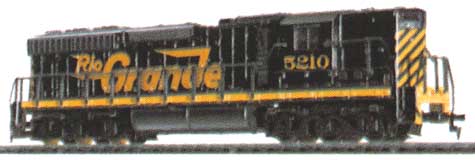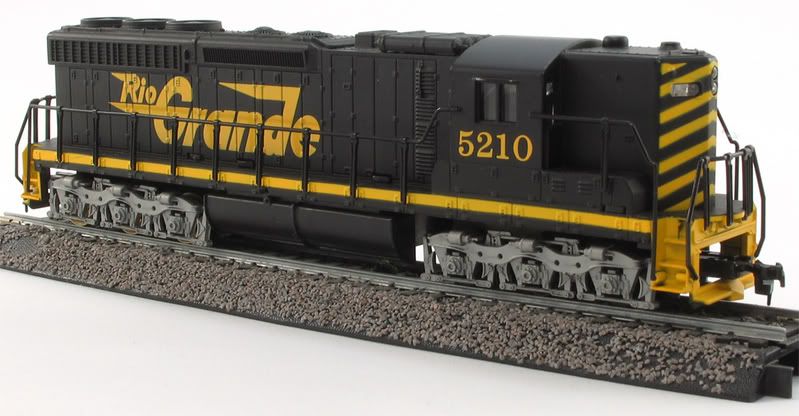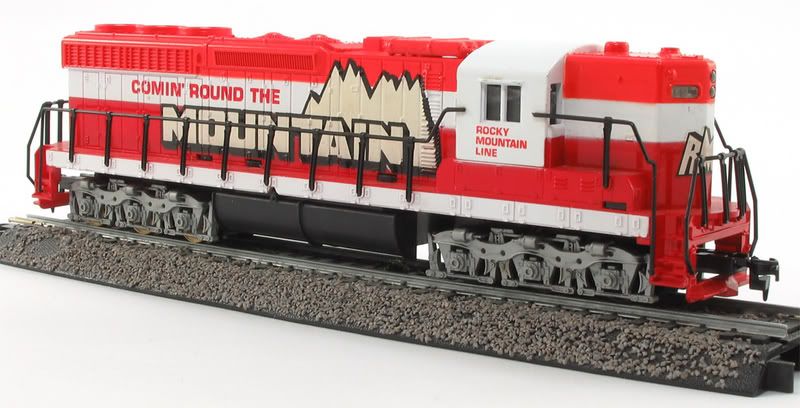|
|
 |
|


SD24 Diesel Locomotive
Burlington
No. 239-13
-1977 Release
TYCO's Burlington SD24 is cataloged from 1977 through 1981. Most catalog pictures used
by TYCO appear to be a Roco-made Atlas SD24 model.


SD24 Diesel Locomotive
Chessie System
No.
239-03 -1980 Release
 
SD24 Diesel Locomotive
Rio Grande
No. 239-74
-1982 Release
There are many differences between the Rio Grande SD24 model
displayed in TYCO's catalogs during the 1980s and what was actually found in production run examples. The first
or top image of the Rio Grande example is the catalog picture for used from 1982 through 1986. Notice
that the catalog model is riding on the same trucks usually found on TYCO's Super630, E7, and GG1. Possibly to
allow for the different height of the trucks, the pilots on the catalog image SD24 are completely open on the bottom.
Both Rio Grande examples are black, but the catalog example features an orange tint to the stripes and lettering.
Also note the stripes on the nose stop at the numberboards and do not run to the top of the model. The second image is a typical example of TYCO's production run Rio Grande SD24. The pilot
has a lower frame and the model rides on the more prototypically appearing trucks that are found on other TYCO SD24s.
The color used for stripes and lettering is a bright yellow and not the orange found in catalog pictures. The cab number
is shown as 5210 in either example, but the production run model does feature stripes on its nose that continue to the
roofline. The regular production Rio Grande SD24 also features yellow steps, while the catalog example has the
orange color applied down its frame sill and on the pilots, but not the steps themselves.

SD24 Diesel Locomotive
R.M.L. -Rocky Mountain Lines
No. 239-27 -1977 Release
Found in TYCO's catalogs from the introduction of its SD24 model
in 1977 through 1979 is the Comin' Round The Mountain - Rocky Mountain Lines SD24. TYCO's catalog images for this example
in many instances were an Atlas model painted in the ficitious R.M.L. scheme.
SD24 Diesel Locomotive
Union Pacific
No.
239-23 -1977 Release
|
 |
|

TYCO's SD24, introduced in 1977, strongly favors the Roco-made SD24
offered by Atlas beginning in 1975. There are differences, TYCO's model does not include a winterization hatch over
one of its back radiator fans as found on the Roco-Atlas example.
In its first catalog appearance for TYCO, SD24 models displayed
are all Atlas locos. This fact can be spotted by noting the grab irons running up the nose of the short hood, more
correctly spaced trucks, fuel tank, and previously mentioned winterization hatch, plus most noticeably the properly
full pilots, that TYCO opens up to allow the talgo coupler to swing freely.
It should also be noted
that SD24 models in later production differ from original appearance. TYCO offered a squeezed in length,
but prototypically correct appearing EMD Flexicoil truck. Late versions offer the odd non-prototypical truck first found
on TYCO's Super 630. The front pilot is also missing the bottom base under the coupler. It seems the different truck
causes the unit to ride a bit higher and therefore created clearance problems for the front coupler.
TYCO's SD24 model makes its last catalog appearance in 1986.
By the 1983 catalog, only Rio Grande is displayed.
TYCO's "Comin' Round The Mountain" set is the only time the SD24 serves
in train set duty, making for rather limited exposure for this model.
|
 |
|
|
 |
|
|
 |
|
|
|
|
Atlas-Roco's SD24 vs. TYCO's SD24
TYCO collector Tony Lucio provides the site with an interesting review
comparison of the 1970s Atlas SD24 produced by Roco in Europe with the Hong Kong-made TYCO SD24. From first viewing
both SD24 models appear similar and it has often been thought that TYCO simply did a knock-off of the Atlas-Roco SD24.
As we'll see, there are many spotting differences between the two SD24 shells. Much appreciation goes to Mr. Lucio for
taking the time to compare the shells and provide the images. The models shown are from Mr. Lucio's collection and consist
of a TYCO Chessie System SD24 and an original Atlas-Roco CB&Q-Burlington Route SD24 both from the 1970s. Thanks
again to Tony Lucio for his efforts and time!
The Atlas-Roco SD24
was available from 1975 to the early 1980s and later with some modficiation was offered by Con-Cor around 1990. Atlas
has in recent years produced a series of very excellent SD24/SD26 models with amazing detail and performance characteristics
under is Master Series line that have no relation to this 1975 SD24 release. The TYCO SD24 disappeared with the TYCO
train line in 1993. IHC-Hobby in 2003 offered a modified example of the original TYCO SD24 tooling.
 Differences between the Atlas-Roco and TYCO SD24 cab and short-hood/nose
are many. The TYCO SD24 includes what appear to be steam generator stacks and a sand hatch filler on the roof of the
short-hood. These details are absent from the Atlas-Roco SD24 model. The addition of the sand hatch filler leaves
less room at the tip of the nose roof and TYCO's hood grab iron is smaller than the Atlas-Roco as a result. The Atlas-Roco
SD24 includes grab irons and ladders up the front of the short-hood/nose, the TYCO model omits these items. Both the
front end headlights and rear headlights share similar differences between the two models. The Atlas-Roco headlights
rest in a more pronounced lens frame or housing, than the TYCO examples. The TYCO headlight lens also appear to
be larger than those on the Atlas-Roco SD24. The Atlas-Roco model includes a pronounced sunshade above the cab windows,
while the TYCO SD24 appears to only include the top frame on its cab window. The Atlas-Roco has two distinctly framed
panes for its cab window, the TYCO window appears slightly larger and looks to be two panes located inside one window frame.
 The roof detail differs greatly across the two examples. The Atlas-Roco
SD-24 includes a winterization hatch on the first radiator fan, the TYCO fans are all exposed. TYCO utilized what appear
to resemble "button-top" or "Dash-2" flavored radiator fans, the Atlas-Roco model has "dome-style" fans. The TYCO model
includes a grab iron encircling the rear radiator fan, a detail not present on the Atlas-Roco SD-24. The addition of
the radiator fan grab iron causes the piping to lay differently on the TYCO model. The Atlas-Roco's piping has a notch
to its path from the rear end down past the radiator fans, the TYCO SD-24's piping curves out and around these fans.
The Atlas-Roco model includes a oval shaped exhaust stack, while the TYCO's exhaust is a square-cornered rectangluar exhaust
with diamond-pattern grille. The Atlas-Roco exhaust suffers too from a very unsightly injection-molding spure.
Door louvers down the sides of the long hood of the Atlas-Roco SD-24 total five sets on both sides of the model (prototypically
correct); the TYCO includes only a single set near the cab along the engineer's side of the long hood and just two columns
of louvers down the fireman's side of the long hood. The Atlas-Roco model features four hinges on the taller doors on
the long hood, TYCO holds its doors with only three hinges on the taller doors. The Atlas-Roco's radiator grilles feature
more detail than the TYCO example, with the Atlas-Roco including rivets, cross-framing and inset diamond grille pattern.
TYCO's radiators are a simplier design with a flat open grid pattern. The profile of the Atlas-Roco's radiator grille
differs from that of the TYCO SD-24, with the Atlas-Roco's grilles come down lower on the carbody to meet the access
doors on the rear of the long-hood's side. The TYCO radiator grilles don't come down as far and include an open space
between the doors and the grilles. The dynamic brake differs between the two examples, with TYCO's running flush along
its length and the Atlas-Roco model has a notch or step going into the dyanmic's grille. The Atlas-Roco SD-24 includes
a handbrake on the engineer's side, a detail missing from the TYCO shell.
 Atlas-Roco SD24's plastic handrails feature a bit thinner stanchion than
the TYCO handrails. The truck sideframes on the TYCO model were
originally produced with the general appearance of the EMD design, though TYCO compresses the triple-truck down to fit the
PowerTorque model's truck size. Late examples of the TYCO SD24 include the completely non-prototypical truck frame applied
to the E7, GG1, and the majority of the Super630 models. Naturally, the TYCO includes a wide open front and rear pilot
to allow for the swing of the model's truck-mounted coupler. The Atlas-Roco features a nicely detailed set of pilots
and body-mounted couplers. The TYCO SD24 features a somewhat correct appearing fuel-tank complete with filler cap.
The Atlas-Roco model suffers from the detail-lacking weight fuel tank, this "feature" was probably the biggest and one of
the few strikes against the design of this series of models when first introduced in 1975. The TYCO model also
features open slots cut into the shell to allow for the snap-in of the trucks and fuel tank. The Atlas-Roco SD24 had
a full frame that snapped onto the shell at the middle of the fuel tank. Finally, the poor TYCO SD24 is powered by the
PowerTorque truck and never was much of a performer, while there doubtless many Atlas-Roco SD24s still proudly serving their
owners to this day.
Below is a portion of the advertisement that announced the first of the Atlas HO-Scale diesel locomotives
in early 1975. The SD24, produced for Atlas by Roco, was quickly followed by the SD35; high-nose and later lose-nose
GP38; GP40; and FP7 models. To see the 1970s Atlas-Roco diesel offerings, click on the image of the Atlas SD24 below...

|
|
|
 |

